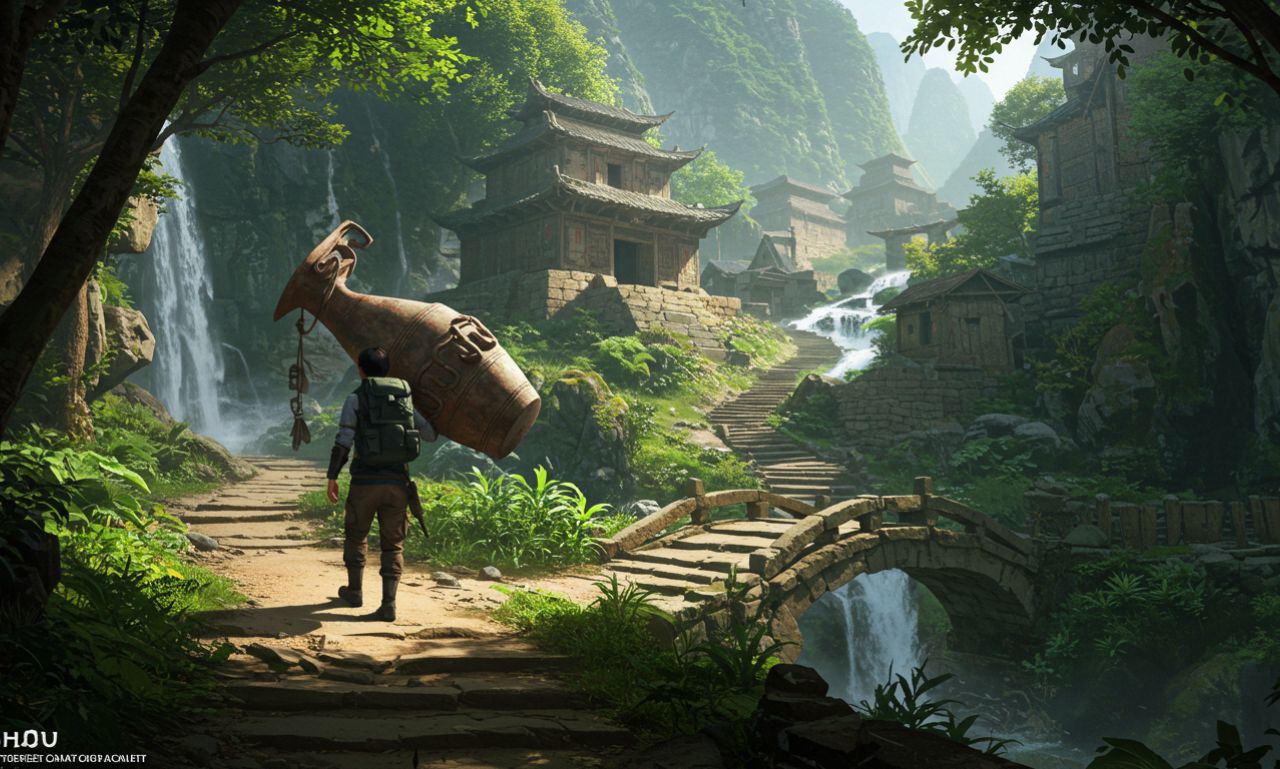The word Tonghou carries a fascinating dual identity. On one hand, it denotes a rare and ceremonial bronze vessel from China’s distant past. On the other, it names a lush and tranquil hiking trail in Taiwan that winds beside a river and through forested mountains. In this article, we unravel both these threads of Tonghou — its origin, design, ritual meaning, archaeological significance, and the natural, cultural, and practical aspects of the Tonghou trail in Taiwan. We journey through history, art, and nature.
The Origins of Tonghou: Ancient Bronze Vessel
The term Tonghou in the context of ancient China refers to a specific class of bronze ritual vessel.
In early Chinese civilization, especially during the Shang (c. 1600–1046 BCE) and Zhou (1046–256 BCE) dynasties, bronze casting was a highly developed art. Tonghou vessels were created in that milieu, for ceremonial and ritual use.
These vessels typically featured square or slightly rectangular bodies, short legs, and often handles or decorative motifs. Their surfaces were embellished with elaborate designs: stylized animals, dragons, geometric patterns — each motif carrying symbolic meaning.
Design and Structure of Tonghou Artifacts
What sets Tonghou apart from other ritual bronzes is its form and symbolic role.
-
Many Tonghou pieces sit on short legs, giving them a slight elevation above the altar or surface.
-
They may have lids or covers, though not always.
-
Handles or grips (sometimes animal or creature shaped) help in carrying or pouring.
-
The decorative motifs often reflect cosmology, power, ancestral authority, or auspicious symbolism.
The ornamentation is not merely aesthetic. In the worldview of ancient China, images of dragons, tigers, birds or mythical creatures invoked protection, spiritual presence, or connection with ancestors. The Tonghou thus operated as a vessel for offering, communication, and ritual potency.
Ritual Use and Symbolism of Tonghou
In traditional ceremonies, Tonghou vessels were used in sacrificial or ancestral rites. Priests, nobles, or members of the ruling class used them to hold food, wine, or symbolic offerings. Through the vessel, they sought to honor ancestors, receive blessings, or manifest their legitimacy as rulers or intermediaries to the spiritual realm.
Because of the importance placed on ritual correctness, the posture, handling, and placement of Tonghou were all prescribed. Improper use could offend divine or ancestral forces.
Over time, as political structures changed and religious practices evolved, many such vessels became museum pieces or archaeological treasures.
Archaeological Discoveries & Importance
Archaeologists have unearthed Tonghou specimens from tombs, ritual sites, and burial contexts. These finds offer critical insight into early bronze casting technology, social hierarchy, religious practice, and artistic style.
Each Tonghou vestige helps researchers date dynasties, trace trade of bronze or ore, and compare artistic evolution across regions. Because Tonghou are relatively rare compared to more common bronzes (like ding or gui), they often carry prestige in museum displays.
In sum, Tonghou is not just a vessel. It is a symbol of early Chinese civilization’s sophistication — in metallurgy, ritual, and symbolism.
Shift to Nature: The Tonghou Trail in Taiwan
While Tonghou evokes ancient art, in Taiwan it brings to mind a serene hiking route: the Tonghou Traversing Trail (桶後越嶺步道) that links Wulai in New Taipei City and Jiaoxi in Yilan County.
Here, “Tonghou / 桶後” literally means “behind the barrel (mountain)” — the “barrel” referring to Mt. Datong (大桶山). Thus the trail’s name alludes to its location behind that landmark.
Originally, the path was one of several indigenous trails used by the Atayal people, for trade, hunting, and movement through mountain terrain.
Trail Route, Length & Difficulty
The Tonghou trail is composed of three major segments:
-
Behind the Barrel Forest Road (12 km one-way): a relatively flat forest road, part asphalt, part compact soil. No permit required.
-
Tonghou Traversing Trail proper (about 6.8 km one-way): more natural trail, with bridges, steps, rope‐assisted parts, creek crossings.
-
Final forest road / descent to Jiaoxi side (about 3 km): double track, mostly soil surface, shady, scenic views.
One can hike out-and-back (start and return same side) or attempt the full traverse (requires arranging pick-up). The trail is classified as moderate — not technically challenging for hikers with basic experience, but caution is needed on slippery or narrow sections.
Total time for the official trail section (6.8 km) is around 3 hours with breaks; including all parts (forest roads) may extend to 5–6 hours depending on pace.
Scenery, Nature & Highlights
Walking the Tonghou trail, one experiences a rich tapestry of landscapes:
-
Dense subtropical forests, abundant ferns, moss, and high humidity.
-
The Tonghou River runs alongside parts of the trail; its waters, cascades, pools, and crossings are a key attraction.
-
Mt. Hongludi (烘爐地山) lies upstream and is often visited together with Tong-hou for a full-day outdoor excursion.
-
Birdsong, butterflies, and the occasional macaque sighting enhance the sense of wilderness.
In spring, mist lingers in the valleys. In summer, the river pools invite cooling dips. Autumn brings crisp air and falling leaves, while winter mornings can be cloaked in fog — each season lending Tonghou a distinct charm.
Ecological & Cultural Value
The Tong hou region is rich in biodiversity — from broadleaf evergreens to bamboo groves. The area shelters insects, reptiles, and small mammals, serving as a living classroom for environmental enthusiasts.
Culturally, the trail preserves the heritage of the Atayal tribe, whose ancestral paths once crossed this terrain. Remnants of hunting shelters and markings hint at that indigenous past. Today, the route blends natural beauty with cultural memory, embodying respect for both nature and heritage.
Preparing for a Hike on the Tonghou Trail
-
Best Time to Visit: Late autumn through early spring when temperatures are mild and humidity lower.
-
What to Bring: Water, light rain gear, walking sticks, insect repellent, and snacks.
-
Safety Tips: Watch for slippery stones during or after rainfall, and avoid crossing flooded sections.
-
Permits: Usually not required for the main route but always check current regulations before hiking.
Those planning the full traverse should arrange transportation or join guided tours, as public transport between entry and exit points is limited.
The Allure of Dual Identity
The beauty of Tonghou lies in its rare dual meaning. In China’s past, it symbolized devotion, artistry, and reverence for ancestors. In Taiwan’s present, it represents nature, endurance, and discovery.
Both meanings share one essence — connection. One connects humans to the divine through ritual; the other connects humans to nature through experience. Together, they form a bridge across time and spirit.
FAQs
What is Tonghou in ancient Chinese culture?
Tonghou refers to a rare bronze ritual vessel from ancient China, used for offerings and ceremonies during the Shang and Zhou dynasties.
Where is the Tonghou trail located?
The Tonghou trail lies between Wulai in New Taipei City and Jiaoxi in Yilan County, Taiwan.
Is the Tonghou trail difficult to hike?
It’s moderately challenging, suitable for beginners with some hiking experience. Some sections can be slippery, especially after rain.
Can I swim in the Tonghou River?
Yes, there are spots safe for dipping, but be cautious of strong currents during rainy seasons.
What is the historical link between Tonghou and indigenous culture?
The trail follows ancient Atayal tribal routes used for trade and migration through Taiwan’s mountain regions.
Why is Tonghou significant today?
It serves as both a cultural artifact of China’s bronze era and a beloved natural landmark in Taiwan, symbolizing a union of art, nature, and history.
Conclusion
Tonghou stands as a bridge between epochs — a symbol that unites the artistry of ancient China and the wild beauty of Taiwan’s mountains. It teaches us that heritage can take many forms: a vessel molded from molten bronze or a winding trail carved by footsteps through time.
To know Tong-hou is to appreciate the enduring bond between humanity, art, and nature — a connection that flows as gracefully as the river itself and gleams as timelessly as bronze under morning light.


